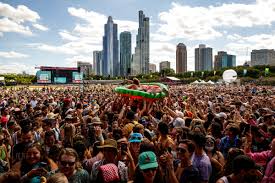
[ad_1]
Lollapalooza is not just a music festival; it’s a cultural phenomenon that has shaped the landscape of live music since its inception in 1991. Over the years, it has transformed from a traveling show into a global brand, captivating millions with its diverse lineup, immersive experiences, and community spirit. This article will take you on a journey through the legendary history of Lollapalooza, exploring its origins, evolution, notable performances, and the impact it has had on music and culture.
The Birth of Lollapalooza
1.1 The Concept Emerges
In the early 1990s, Perry Farrell, the frontman of the iconic band Jane’s Addiction, envisioned a festival that would showcase emerging alternative bands. The idea was to create a platform for these artists while also celebrating diversity in music. The name “Lollapalooza” is derived from a 1920s slang term that meant “extraordinary” and was often used to describe something wonderful. Thus, the inaugural Lollapalooza was born in 1991 as a national touring festival, combining rock, hip-hop, and much more into one schedule.
1.2 The First Festival: 1991
The very first Lollapalooza took place in July 1991 and featured an eclectic lineup, including Jane’s Addiction, Living Colour, Ice-T, and the Butthole Surfers. The festival was a groundbreaking event that attracted an impressive crowd, setting the stage for its future success. It marked a turning point in live music, offering an alternative to the dominant mainstream festivals of the time.
Lollapalooza’s Evolution
2.1 From Touring Festival to Single Location
Initially designed as a traveling festival, Lollapalooza saw varying degrees of success with different lineups each year. However, by 1997, the festival began to struggle with profitability. It took a hiatus in 1998 but returned in 2003 with a renewed focus. This time, Lollapalooza settled in Grant Park, Chicago, establishing an iconic home base. This marked the beginning of Lollapalooza’s transition into a destination festival.
2.2 The Transformation: 2005 Onwards
The transformation of Lollapalooza into a destination festival paid off spectacularly. The 2005 lineup featured big names such as The Killers, the Pixies, and Widespread Panic. Attendance grew exponentially, allowing for more elaborate stages, art installations, and food options. Over the years, Lollapalooza has continued to broaden its appeal, drawing fans from all walks of life.
Notable Performances and Lineups
3.1 Landmark Acts
Throughout its history, Lollapalooza has played host to some of the biggest names in music. From mainstream superstars to underground bands, the lineup has been a rich tapestry of sound.
3.1.1 1994: The Ultimate Grunge Lineup
One of the most memorable years was 1994, as it featured the last tour of the legendary band Nirvana. Alongside them were Smashing Pumpkins, Beastie Boys, and The Offspring, marking one of the most iconic festivals in Lollapalooza’s history.
3.1.2 2010: A New Era Begins
2010 was a pivotal year for Lollapalooza with performances from Lady Gaga, Green Day, and the Strokes. The festival began to recognize the growing electronic music scene, incorporating acts like Hot Chip and MGMT. This era of Lollapalooza demonstrated a shift towards capturing a broader audience and embracing diverse genres.
3.2 Emerging Artists
Lollapalooza has also been pivotal in spotlighting emerging artists. Acts that later became household names – such as Billie Eilish in 2019 – have graced its stages long before they achieved mainstream success. This commitment to showcasing new talent continues the festival’s legacy of being a launchpad for the next big thing in music.
The Cultural Impact of Lollapalooza
4.1 Fostering Community
Lollapalooza is about more than just music; it fosters a vibrant community atmosphere that encourages fans to connect with one another. The festival culture emphasizes inclusivity and acceptance, aligning with the youthful spirit of the music it celebrates. Each year, thousands of fans come together to share in the experience, whether they’re discovering new artists or reliving nostalgic moments with their favorite bands.
4.2 Economic Influence
With its annual draw of over 400,000 attendees, Lollapalooza significantly impacts Chicago’s economy. The festival generates millions in revenue for local businesses, hotels, and restaurants. In addition, it provides job opportunities for many locals, enhancing community involvement and support.
4.3 Environmental Advocacy
Lollapalooza has made strides in promoting sustainability and environmental awareness. The festival implements eco-friendly practices, including recycling and composting stations, to minimize waste. The “Lolla Cares” initiative encourages both attendees and vendors to consider their environmental impact, showcasing the festival’s commitment to a greener future.
The Global Expansion of Lollapalooza
5.1 International Editions
Due to its success, Lollapalooza has expanded internationally, with editions in various countries, including Brazil, Argentina, Germany, and France. This global outreach has allowed the brand to reach new audiences and introduce diverse musical cultures, further solidifying Lollapalooza’s status as a worldwide music festival.
5.2 Unique Local Flavors
Each international edition of Lollapalooza features a lineup that reflects the local music scene while maintaining the festival’s core essence. For instance, Lollapalooza Brazil is known for heavily featuring Brazilian artists alongside international stars, offering attendees a unique blend of sounds and cultures.
Behind-the-Scenes: Organizing Lollapalooza
6.1 The Logistics
Organizing an event of Lollapalooza’s scale is no small feat. From securing permits and planning stages to coordinating logistics for thousands of attendees, the planning process is intricate and multifaceted. The festival typically requires over a year of preparation, involving a dedicated team of professionals who ensure every detail is meticulously attended to.
6.2 Artist Relations
Maintaining relationships with artists is also critical to ensuring a successful festival. The organizers negotiate contracts, provide hospitality offerings, and create optimal performance conditions for each act. Understanding the needs of artists and providing them a conducive environment to perform goes a long way in securing top-tier talent for future iterations.
The Future of Lollapalooza
7.1 Innovations in Experience
With the rapid evolution of technology, Lollapalooza is continuously looking for ways to enhance the attendee experience. From virtual reality experiences to interactive installations, the festival embraces innovation to keep itself relevant in a fast-changing industry.
7.2 The Continuation of Diversity
As music genres continue to evolve, Lollapalooza’s commitment to diversity ensures it remains a prominent player in the global festival circuit. The upcoming years will likely see an even broader array of musical genres represented, reflecting the changing tastes of audiences worldwide.
Conclusion
Lollapalooza is more than just a music festival; it’s a celebration of culture, community, and creativity. From its humble beginnings as a touring show to its status as a global phenomenon, the festival has established a rich legacy that continues to grow. Each year, Lollapalooza captures the spirit of the times, showcasing both legendary acts and rising stars. As it looks to the future, it’s clear that Lollapalooza will continue to be a pivotal force in the world of music festivals.
FAQs about Lollapalooza
What is Lollapalooza?
Lollapalooza is an annual music festival that showcases a diverse lineup of artists across multiple genres, created by Perry Farrell in 1991.
Where is Lollapalooza held?
The flagship Lollapalooza takes place in Grant Park, Chicago, but it also has international editions in countries like Brazil, Argentina, Germany, and France.
How long does Lollapalooza last?
Lollapalooza typically runs for four days, featuring multiple stages with performances from various artists throughout each day.
Can I volunteer at Lollapalooza?
Yes! Lollapalooza offers volunteering opportunities that allow individuals to contribute to the festival while gaining experience in event organization.
What should I bring to Lollapalooza?
It’s advisable to bring items such as sunscreen, a refillable water bottle, comfortable shoes, and a portable charger to enhance your festival experience.
Is Lollapalooza family-friendly?
Yes, Lollapalooza is family-friendly and welcomes attendees of all ages, with certain activities and zones designed specifically for children.
With its storied past and commitment to innovation, Lollapalooza remains a beacon of musical celebration and community vibes in our increasingly interconnected world. The festival not only showcases the best in music but also exemplifies the art of bringing people together, shaping the future of live experiences for years to come.
[ad_2]





